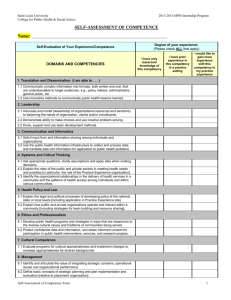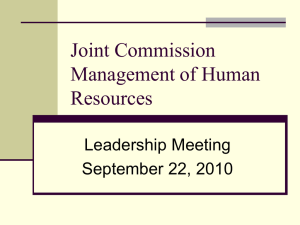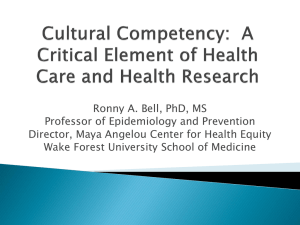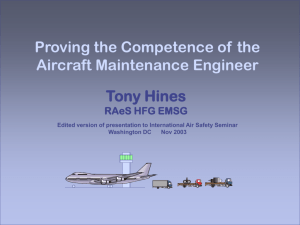North Carolina Department of Public Instruction Global-Ready Schools Designation
advertisement
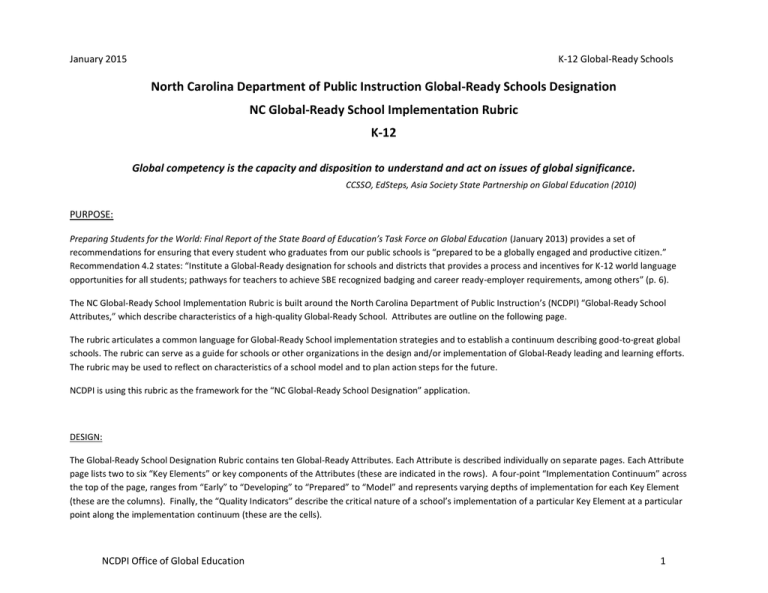
January 2015 K-12 Global-Ready Schools North Carolina Department of Public Instruction Global-Ready Schools Designation NC Global-Ready School Implementation Rubric K-12 Global competency is the capacity and disposition to understand and act on issues of global significance. CCSSO, EdSteps, Asia Society State Partnership on Global Education (2010) PURPOSE: Preparing Students for the World: Final Report of the State Board of Education’s Task Force on Global Education (January 2013) provides a set of recommendations for ensuring that every student who graduates from our public schools is “prepared to be a globally engaged and productive citizen.” Recommendation 4.2 states: “Institute a Global-Ready designation for schools and districts that provides a process and incentives for K-12 world language opportunities for all students; pathways for teachers to achieve SBE recognized badging and career ready-employer requirements, among others” (p. 6). The NC Global-Ready School Implementation Rubric is built around the North Carolina Department of Public Instruction’s (NCDPI) “Global-Ready School Attributes,” which describe characteristics of a high-quality Global-Ready School. Attributes are outline on the following page. The rubric articulates a common language for Global-Ready School implementation strategies and to establish a continuum describing good-to-great global schools. The rubric can serve as a guide for schools or other organizations in the design and/or implementation of Global-Ready leading and learning efforts. The rubric may be used to reflect on characteristics of a school model and to plan action steps for the future. NCDPI is using this rubric as the framework for the “NC Global-Ready School Designation” application. DESIGN: The Global-Ready School Designation Rubric contains ten Global-Ready Attributes. Each Attribute is described individually on separate pages. Each Attribute page lists two to six “Key Elements” or key components of the Attributes (these are indicated in the rows). A four-point “Implementation Continuum” across the top of the page, ranges from “Early” to “Developing” to “Prepared” to “Model” and represents varying depths of implementation for each Key Element (these are the columns). Finally, the “Quality Indicators” describe the critical nature of a school’s implementation of a particular Key Element at a particular point along the implementation continuum (these are the cells). NCDPI Office of Global Education 1 January 2015 K-12 Global-Ready Schools ACKNOWLEDGEMENTS: NCDPI acknowledges and appreciates the following for their collaboration on the Attributes: North Carolina Center for International Understanding, VIF International Education, and World View. NDDPI also acknowledges and appreciates The Friday Institute of North Carolina State University for their collaboration and the development of this rubric. NCDPI Office of Global Education 2 January 2015 K-12 Global-Ready Schools North Carolina Department of Public Instruction’s NC Global-Ready School Attributes* Early Developing Prepared Model A Global-Ready School demonstrates its commitment to prepare students for the world through sustainable strategic planning. 1. A site-based global education strategic plan is in place that supports the development of globally competent students and invlolves students, faculty, parents, local and global communities. 2. A site-based global education committee or advisory council is in place to address the goals of the global education strategic plan. A Global-Ready School demonstrates teaching and learning practices by integrating global themes throughout curriculum, aligned with state, national, and international business/industry standards. 3. Professional development on embedded global education curriculum. 4. Embedded global themes and problem-based learning throughout the curriculum. 5. Global experiential learning experiences (face-to-face and virtual) for each student and teacher. 6. Alignment of student global competency development with career and/or postsecondary pathways. 7. Leading-edge language instruction. 8. Authentic assessment and demonstration of global competence. A Global-Ready School initiates and sustains local, national, and international community and business/industry partnerships. 9. Global education strategic plan is communicated. 10. Business/industry, nonprofit, and community partnerships for Global Education opportunities that extend the classroom walls. * Attributes define essential components central to 21st century skills NCDPI Office of Global Education 3 January 2015 K-12 Global-Ready Schools 1. A site-based global education strategic plan is in place that supports the development of globally competent students and involves students, faculty, parents, local and global communities. Key Elements Early Developing Prepared Model 1.1 Definition of global competency* School plan includes a global competency in the mission and/or vision statement. School plan indicates comprehensive approach to integrate global competency mission and/or vision statement into the curriculum. School plan indicates comprehensive approach to integrate global competency mission and/or vision statement into the standards-based curriculum and references relevant research and resources. School plan demonstrates comprehensive integration of global competence into the standards-based curriculum through action items and references to relevant research and resources. 1.2 Global competence goals. School plan includes statement of need for global competence goals. School plan indicates staff and student goals for global competence. School plan indicates comprehensive staff and student goals for global competence, and identifies tools and resources. School plan indicates comprehensive staff and student goals for global competence, identifies relevant tools and resources, and articulates a plan to help students and staff meet those goals. 1.3 School resources School plan includes statement of need to identify the resources to meet global competence goals. School plan identifies human and material resources needed for some departments and personnel. School plan identifies human and material resources needed for many departments and personnel. School plan includes the specific identification of human and material resources needed for all departments and personnel. 1.4 Professional development School plan includes a professional development (PD) plan with limited acknowledgement of global competency goals. School plan includes a PD plan for 20-49% of staff to build and support knowledge, skills, and dispositions for global competence. School plan includes comprehensive PD plan for 50-85% of staff to build and support knowledge, skills, and dispositions for global competence. School plan includes comprehensive PD plan for all staff to build and support knowledge, skills and dispositions for global competence. 1.5 Global educator designation School plan includes goal for school educators to achieve State Board of Education (SBE) Global Educator Digital Badge (GEDB) designation. School plan includes goal for 10% of school educators to be enrolled in the process for attaining or have attained the GEDB designation. School plan includes goal for at least 30% of staff to be enrolled in the process for attaining or have attained the GEDB designation. School plan includes goal for at least 50% of staff to be enrolled in the process for attaining or have attained the GEDB designation. NCDPI Office of Global Education 4 January 2015 K-12 Global-Ready Schools 1. A site-based global education strategic plan is in place that supports the development of globally competent students and involves students, faculty, parents, local and global communities. 1.6 Committee** structure and processes. School plan identifies a need to establish a committee on global education. School plan includes guidelines for participation of some stakeholders in global education committee. School plan includes guidelines for participation of all stakeholder groups in global education committee. School plan includes guidelines that ensure participation of all stakeholder groups in global education committee structure and processes. * Global competency is the capacity and disposition to understand and act on issues of global significance. (CCSSO. EdSteps, State Partnership on Global Ed: 2010) ** The committee can be part of the existing school level site-based management structure such as the School Improvement Team. NCDPI Office of Global Education 5 January 2015 K-12 Global-Ready Schools 2. A site-based global education committee* or advisory council is in place to address the goals of the global education strategic plan. Key Elements Early Developing Prepared Model 2.1 Frequency of collaboration Global education committee meets infrequently. Global education committee meets at least annually to review the plan. Global education committee meets at least each semester to reflect, assess, revise, and implement the plan. Global education committee meets at least quarterly to reflect, assess, revise, and implement the plan. 2.2 School decisionmaking processes Global education committee is separate from the school's decision-making processes. Global education committee connects to school decision-making processes to integrate global focus. Global education committee influences school decisionmaking processes to integrate global focus. Global education committee impacts school decisionmaking processes to effectively integrate global focus and leverage resources to meet each goal of the strategic plan. * The committee can be part of the existing school level site-based management structure such as the School Improvement Team. NCDPI Office of Global Education 6 January 2015 K-12 Global-Ready Schools 3. Professional development on embedded global education curriculum. Key Elements Early Developing Prepared Model 3.1 Frequency Few teachers participate in annual PD that focuses on global content, pedagogy, and technology. At least 25% of teachers participate in 10-20 hours in PD annually that focuses on global content, pedagogy, and technology tools to enhance the global content of their discipline. At least 50% of teachers participate in 10-20 hours in PD annually that focuses on global content, pedagogy, and technology tools to enhance the global content of their discipline. At least 75% of teachers participate in 10-20 or more hours in annual PD that focuses on global content, pedagogy, and technology. All teachers are trained to use digital tools to enhance the global content of their discipline. 3.2 Standardsbased, content specific connection Up to 25% of contentrelated PD makes explicit efforts to connect relevance of global competency with standards-based curriculum. 26-50% of annual contentrelated PD makes explicit efforts to connect relevance of global competency with standards-based curriculum. 51-75% of annual contentrelated PD makes explicit efforts to connect relevance of global competency with standards-based curriculum. More than 75% of contentrelated annual PD makes explicit efforts to connect relevance of global competency with standardsbased curriculum. 3.3 Personalized Learning Up to 25% of teachers participate in PD sessions that incorporate general global education strategies. 26-50% of teachers participate in sessions that include strategies for inquiry-based instruction that integrates global education. 51-75% of teachers identify personal global education PD goals and seek PD activities to meet individual professional goals. More than 75% of teachers identify personal global education PD goals and seek PD activities to meet individual professional goals. 3.4 Jobembedded* Job-embedded global education practice-based approach is used only for some staff (e.g., teachers, media specialists). Job-embedded global education practice-based approach is used quarterly for all staff. Job-embedded global education practice-based approach is used monthly for all staff. Job-embedded global education practice-based approach is used multiple times per month for all staff. *Job-embedded includes action research, evidence of learning, peer observation, peer review, critical friends feedback, lesson study, etc. NCDPI Office of Global Education 7 January 2015 K-12 Global-Ready Schools 4. Embedded global themes and problem-based learning throughout the curriculum. Key Elements Early Developing Prepared Model 4.1 Integrating global content into curriculum School has clearly defined global themes. Global themes are connected to content areas (i.e., math, science, etc.). Global content has been fully integrated into most standards and into most disciplines. Global themes are connected to content and are purposefully interdisciplinary. Engaging global content has been fully integrated into all standards and into all disciplines. Global themes are mapped vertically and horizontally. Scope and sequence of connections between global issues and content are purposeful. 4.2 Relevant inquiry-based instruction around global themes Classroom experience dominated by memorization and recall of global themes and issues. Classroom experience involves discussion of global themes. Classroom experience includes collaborative problem-solving of global issues that may include real world, current problems. Classroom experience includes collaborative investigation, problemsolving of real global issues and articulation of personal and multiple perspectives. 4.3 Assessment for learning Students can recall global themes and define them. Students can articulate global themes and justify their importance. Students demonstrate competence in collaboration and develop appropriate theoretical solutions to global issues. Students demonstrate competence in collaboration and peer assessment and are able to articulate the collaborative process in the development of appropriate theoretical solutions to global issues. NCDPI Office of Global Education 8 January 2015 K-12 Global-Ready Schools 5. Global learning experiences (face-to-face and virtual) for each student and teacher. Key Elements Early Developing Prepared Model 5.1 Instructional approach is inquiry-based Students identify a global issue or need (e.g., scarcity of water). Students identify a global issue or need and conduct research to investigate current measures in place to address the need. Technology is used for part of the inquiry process. Students identify a global issue or need, identify current measures in place, and explain the importance of this issue in the context of other global concerns. Technology is used throughout the inquiry process. Students identify a global issue or need, develop a plan to address it, implement the plan, and reflect upon the plan's efficacy. Technology is used throughout the inquiry process. 5.2 Local global connections School has an event during year that celebrates the heritage of the student body and local community. School builds on multiple events that celebrate the heritage of the student body and local community. Some teachers bring local global connections into the classroom through guest speakers and field trips. School's student body heritage is intentionally mapped into curriculum and intentionally highlighted throughout the year. Local immersions with different communities exist during some classes. Strong partnerships with local global communities, organizations, and nonprofits encourage students to explore multiple perspectives. School has developed partnership with a school abroad, and students and teachers connect with that school virtually. 5.3 Experiential learning* Virtual global learning experiences are sometimes planned. Virtual and face-to-face global learning experiences are offered to students, but are not always aligned with the curriculum. School leaders acknowledge the importance of international exchange to build global competence in teachers and students. Virtual and face-to-face global learning experiences are accessible to some students and are aligned with the curriculum. School leaders encourage international exchange for teachers and students. Media center is emerging as a global hub. Virtual and face-to-face global learning experiences are strategically implemented across the curriculum. Experiential learning is accessible to all. Travel opportunities are intentional and aligned to curriculum. Media Center is a global hub. NCDPI Office of Global Education 9 January 2015 K-12 Global-Ready Schools 5. Global learning experiences (face-to-face and virtual) for each student and teacher. 5.4 Global service Teachers and students identify possible venues to provide service to a part of the global community (e.g., neighborhood park, school). Teacher and student creation and implementation of plans to provide service to a part of the global community is supported by the school plan. At least 25% of students and teachers provide service based on a school supported plan to a part of the global community (e.g., peer tutoring for English homework). At least 50% of students and teachers provide service based on a school supported plan to a part of the global community**. * Experiential learning is investigative, collaborative learning within a community. ** The global community includes culturally and ethnically diverse communities in the local area and across the globe. NCDPI Office of Global Education 10 January 2015 K-12 Global-Ready Schools 6. Alignment of student global competency development with career and/or postsecondary pathway. Key Elements Early Developing Prepared Model 6.1 The curriculum provides Integrating some discussion of global global competency. competency into curriculum pathways. The curriculum provides some discussion of global competency related to career and postsecondary pathways. The curriculum provides a systematic process to integrate global competency related to career and postsecondary pathways. The curriculum provides a systematic process to integrate global competency using age-appropriate projects considering individual students' global competency related to career and postsecondary pathways. 6.2 Students explore definition Career related of global citizenship.* and/or postsecondary global learning skills Students have clear definitions of global citizenship and sometimes discuss global issues that are relevant to them. Students sometimes demonstrate global citizenship. They are able to demonstrate understanding of global issues from different points of view. Some students participate in a global project. Students demonstrate global citizenship growth over time. Students systematically understand and act on issues of global significance through a global project. * Global citizenship means that as citizens of the world, we have responsibilities to each other and to the earth itself. NCDPI Office of Global Education 11 January 2015 K-12 Global-Ready Schools 7. Leading-edge language instruction. Key Elements Early Developing Prepared Model 7.1 Students in language programs School is developing plan to implement proficiencybased world language instruction in the next school year. 15-49% of all students enrolled in proficiencybased world language instruction and/or school has a dual language/immersion (DLI) program that is part of a district K-12 DLI initiative. 50-80% of all students enrolled in proficiencybased world language instruction and/or school has a dual language/immersion (DLI) program that is part of a district K-12 DLI initiative All students enrolled in proficiency based world language instruction that is integrated into the district K-12 world language/ DLI plan that leads to higher world language proficiency and cultural competency levels. 7.2 Strategic language programs offered School is developing plan to offer world language instruction as part of the district K-12 articulated world language program. At least one world language offered at the school or through virtual partners. Based on identified local community needs and resources, additional strategic language programs are offered at the school. Based on local and regional needs, additional strategic language programs are offered at the school with the assistance of community, regional, international or virtual partners. 7.3 High-quality resources for instruction The school provides world language instruction or content-based instruction, such as in partial or full immersion in the world language. Curriculum documents for World Language and/or dual language/immersion (DLI) instruction are aligned with the NC World Language Essential Standards. The district seeks partnerships at the local, regional, and state level for teachers and resources. Curriculum documents reflect research-based scope and sequence for language and culture learning for the world language/DLI program and are aligned to the NC World Language Essential Standards. Technology resources are utilized for instruction and classroom formative or summative assessment of language proficiency and cultural competency. Some opportunities for interaction with native speakers are available. The school embraces a research-based model for all world language programs and is aligned with the NC World Language Essential Standards program language proficiency and cultural competence outcomes. Technology resources are utilized for instruction and formative or summative assessment of language proficiency program outcomes and cultural competency, inclusive of external assessments. Access to native speakers of language of study is through teachers, classroom partnerships, virtual conversation partners and others. NCDPI Office of Global Education 12 January 2015 K-12 Global-Ready Schools 7. Leading-edge language instruction. 7.4 Students demonstrate language and cultural competencies Multiple choice and single response assessments are used to demonstrate student language and cultural knowledge and competencies. Performance-based assessments are used to demonstrate student language and cultural competence in alignment with the NC World Language Essential Standards. Formative assessment tools and performance-based assessments are used to demonstrate student language and cultural competence, in accordance with the program outcomes for the language program model in alignment with the NC World Language Essential Standards. A comprehensive and balanced assessment approach, along with validated instruments, is used to provide students multiple opportunities to demonstrate language proficiency and cultural competence, in accordance with the program outcomes for the language program model in alignment with the NC World Language Essential Standards. 7.5 Multiple opportunities to learn Opportunities are available for students to learn about world language and culture. Opportunities are available for students to participate in world language instruction world language clubs, field trips, and virtual opportunities to experience world languages. Opportunities are available for students to participate in world language instruction or dual language/immersion instruction, clubs, field trips, virtual exchanges, or additional immersion study for some students and some teachers. Opportunities are available for students to participate in classroom world language study, immersion study, study abroad, community service events, international exchange, international travel, and/or language clubs for majority of students and teachers. NCDPI Office of Global Education 13 January 2015 K-12 Global-Ready Schools 8. Authentic assessment and demonstration of global competence. Key Elements Early Developing Prepared Model 8.1 Crosscurricular inquiry-based assessment* Students are assessed on teacher-created, non-authentic assessment. 10-40% of all subjects/courses assess student global competence through performance based assessments. 41-70% of all subjects/courses assess students’ global competence as related to the curriculum and utilizing performance-based assessments. 71-100% of subjects/courses assess global competence as related to the curriculum of the course utilizing performance-based assessments with studentgenerated rubrics. 8.2 Students demonstrate global competency and proficiency of world languages Schools provide at least one tool for students to demonstrate competency/ proficiency (i.e., validated instrument, standardized test, portfolios, or capstone projects). Schools provide some tools for students to demonstrate competency/proficiency (i.e., validated instruments, standardized tests, portfolios, or capstone projects). Schools provide many tools for students to demonstrate competency/proficiency, including validated instruments, standardized tests, portfolios, or capstone projects. Schools have comprehensive school-wide assessment approach utilizing validated instruments for global competency/proficiency including validated instruments, standardized tests, portfolios, or capstone projects. 8.3 Teachers demonstrate global competence Schools provide at least one tool for teachers to demonstrate global competence. Schools provide some tools for teachers to demonstrate global competence. Schools provide many tools for teachers to demonstrate global competence, including validated instruments. Schools have comprehensive assessment approach and offer validated instruments that provide teachers opportunities to demonstrate global competence. * Inquiry-based assessment includes performance-based learning, project-based learning, project-based inquiry, problem-based learning, design cycle, performance-based assessment, etc. NCDPI Office of Global Education 14 January 2015 K-12 Global-Ready Schools 9. Global education strategic plan is communicated. Key Elements Early Developing Prepared Model 9.1 Communicate global education plan Program leaders infrequently communicate the global education plan to garner participation and buy-in from global education teachers and key stakeholders. Program leaders annually communicate the global education plan to garner participation and buy-in from global education teachers and key stakeholders. Program leaders semiannually communicate the global education plan to garner participation and buyin from teachers and key stakeholders. Program leaders communicate plan to surrounding early and developing schools. Program leaders often communicate the global education plan to garner participation and buy-in from teachers and key stakeholders. Program leaders reach out to early and developing schools in the district and promote global education plan. 9.2 Communicate program data A variety of school/programlevel student data on global education performance (e.g., test scores, work samples) is available annually to administrators and teachers and is used to inform decisions. A variety of school/programlevel student data on global education performance (e.g., test scores, work samples) is available semiannually to administrators and teachers, and is used to inform instructional and programmatic decisions. A variety of school/programlevel student data on global education performance (e.g., test scores, work samples) is available quarterly to administrators and teachers, and is used to inform instructional and programmatic decisions throughout the year. A variety of school/programlevel student data on global education performance (e.g., test scores, work samples) is available monthly to administrators and teachers, and is used to inform instructional and programmatic decisions throughout the year. 9.3 One-way communication Communication tools (i.e., websites and tools newsletters) and/or two-way tools (i.e., social media platforms, webinars, and meetings) are used annually to communicate internally and externally about global education program activities. One-way communication tools (i.e. websites and newsletters) and/or two-way tools (i.e. social media platforms, webinars, and meetings) are used semiannually to communicate internally and externally about global education program activities. One-way communication tools (i.e., websites and newsletters) and/or two-way tools (i.e., social media platforms, webinars, and meeting), are used quarterly to communicate internally and externally about global education program activities. One-way communication tools (i.e., websites and newsletters) and/or two-way tools (i.e., social media platforms, webinars, and meetings) are used monthly to communicate internally and externally about global education program activities. NCDPI Office of Global Education 15 January 2015 K-12 Global-Ready Schools 10. Business/industry, nonprofit, and community partnerships for Global Education opportunities that extend the classroom walls. Key Elements Early Developing Prepared Model 10.1 Learning connected to industries/ endeavors Program leaders are researching and planning in-school learning opportunities for students on content that is directly connected to current work in global-related industries/endeavors. 2 or less school learning opportunities (i.e., projects, activities, etc.) for all students focus on content directly connected to correct work in global industries/endeavors. Several in-school opportunities (i.e., projects, activities, etc.) for all students focused on content directly connected to current work in global industries/endeavors. In-school learning opportunities (i.e., projects, activities, etc.) for all students frequently focus on content directly connected to current work in global industries/endeavors. 10.2 Students interact with global industries /endeavors Program leaders are researching and planning active learning experiences with an external global industry/endeavor partner, either during or outside of the school day. At least 25% of students have at least 1 active learning experience annually with an external global industry/endeavor partner, either during or outside of the school day. At least 50% of students have at least 1 active learning experience annually with an external global industry/endeavor partner, either during or outside of the school day. At least 75% of students have an active learning experience annually with an external global industry/endeavor partner, either during or outside of the school day. 10.3 Collaboration in network of schools Program leaders are researching and planning participation in a network of schools or school leaders that addresses global education issues. School/program leadership participates annually in an active online network of schools or school leaders that addresses global education issues. School/program leadership participates annually in a face-to-face or at least semiannually in an active online network of schools or school leaders that addresses global education issues. School/program leadership participates annually in a face-to-face or at least quarterly in an active online network of schools or school leaders that addresses global education issues. NCDPI Office of Global Education 16
